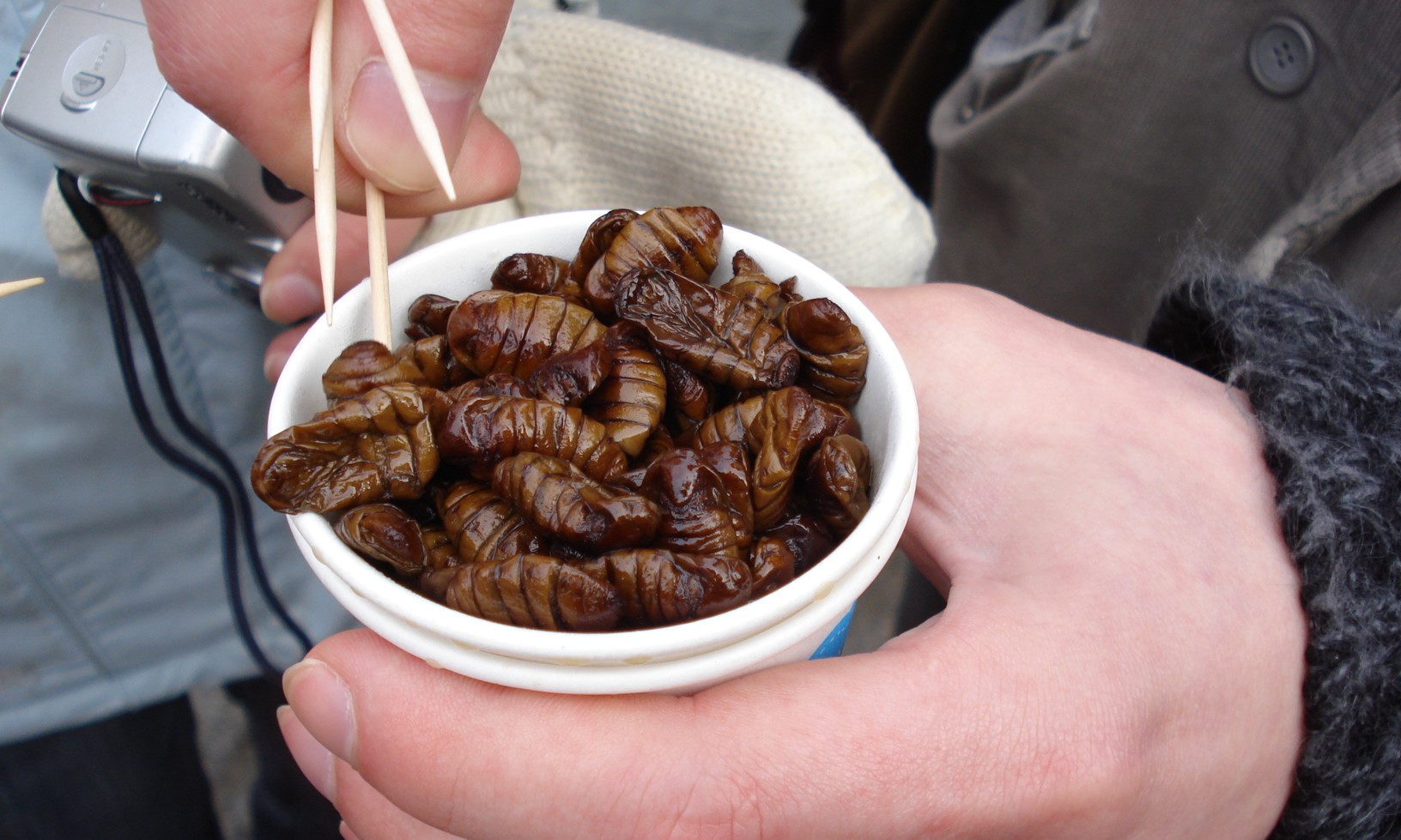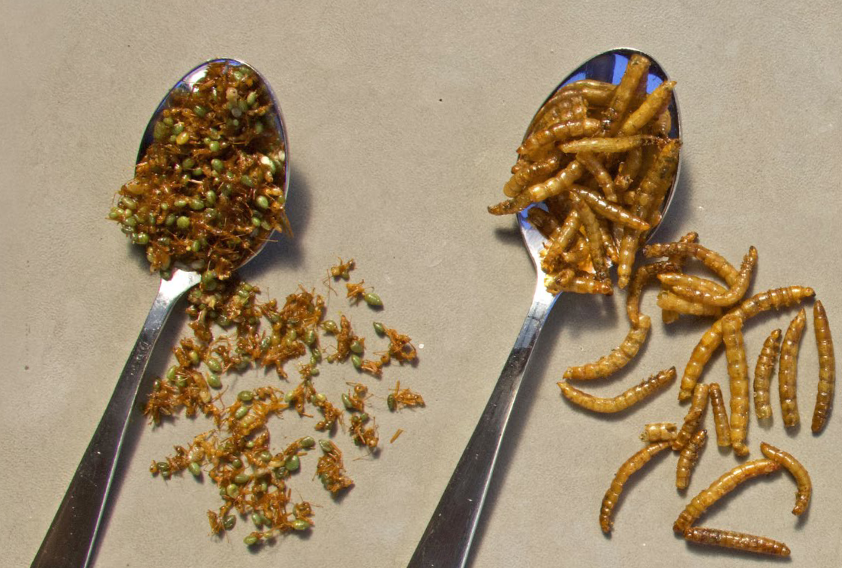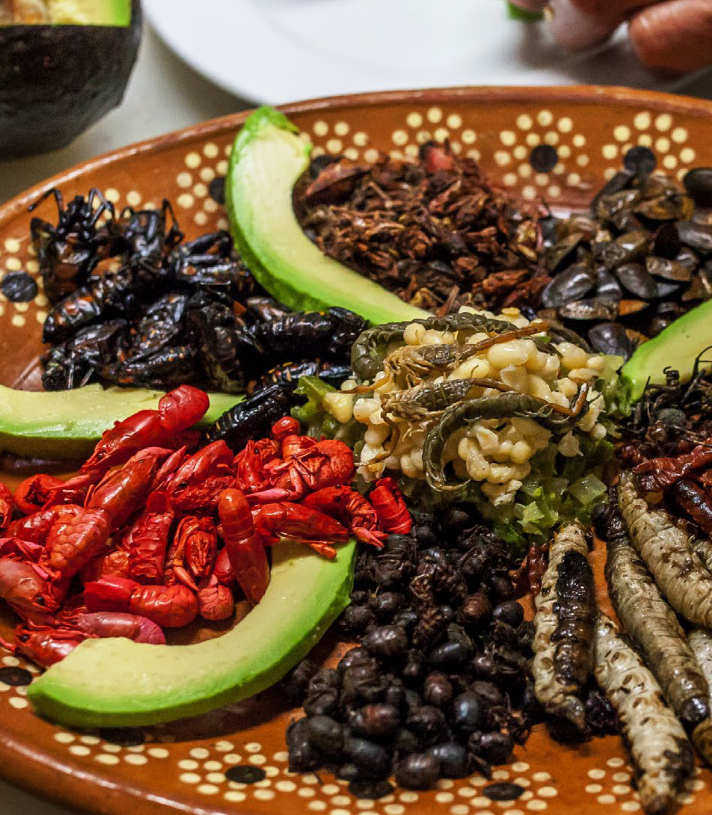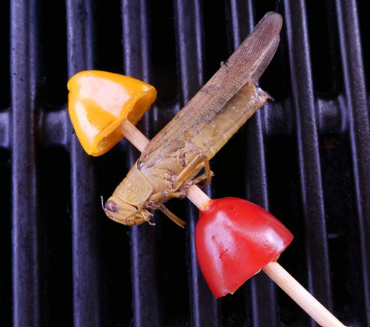
You Will Eat Bugs. You Will Enjoy Them
If you had free choice for stimulating conversation, who would you invite to dinner around your kitchen table? Personally, I’d accept Taylor Swift, Lady Gaga and Nicole Kidman, and serve my favourite Peking duck from a Luv-a-Duck box.
If they’re unavailable, I’d settle for my Climate Council pals Tim “Ghost Metropolis” Flannery, his CEO Amanda McKenzie and co-Councillor Joelle Gergis. But what to serve them? They’d want to maintain their tiny food-carbon footprints. In the climate emergency, as global boiling accelerates on our highway to hell, they’d surely be on planet-friendly insect diets. I’d select the sustainable insects approved for human food by our Ag Department.
For entrée I’d serve ground Achaeta domestica (house crickets). Mains would be a paste of Zophobas morio (super mealworms), drizzled with a jus from black soldier ant larvae.[1] Dessert? Whole Tenebrio molitor (mealworm beetles).
The best news for the Climate Council trio is that the three species are certain to be augmented soon to many more creepies, crawlies and buzzing fliers. The Straits Times reported last month the Singapore Food Agency’s approval of an expanded list of 16 plate-ready bugs. Among the endorsed species (“Grub’s on! Come and get it!”) are four crickets, two moths, a grasshopper, three mealworms, silkworms, two locusts, a honeybee and “a Giant Rhino Beetle Grub”. Nothing surprises me about Singapore’s cuisine — during my visit last year, a restaurant menu on New Bridge Road included “Fried Jew’s Ear”.[2]
As the Guardian exults, “From fried silk worm pupa to protein bars packed with ground mealworm, Singapore’s long list of edible insects could be a sign of things to come. Singapore paves the way for plates to become wrigglier, leggier and more sustainable.” Singapore also gets plaudits in the Guardian from Skye Blackburn of Edible Bug Shop, an Australian entomologist and food scientist. Her website says,
Skye feels that by educating people about the way that edible insects can be farmed as a eco-friendly alternative protein, she can help reduce some of the misconceptions about eating bugs. You don’t just have to eat bugs if you are stuck in the bush and have nothing else to eat. When prepared properly, and you get over the initial YUCK factor, bugs are very tasty and are also good for you (and the environment).
Her offerings include VitaBug Snack Crickets- Barbeque in $15 stand-up pouches with a clear viewing window:
Not too spicy but ohh so yummy! … Each pack contains approximately 30-40 roasted crickets. This is a ready to eat product … These are whole crickets, some customers prefer to remove wings and/or legs before consumption.
This reminds me of a playground chant at my Nedlands State School, Perth, which went:
A boy stood on the burning deck
Eating blowflies by the peck.[3]
“Father, may I eat the wings?”
No no my son! They’re dirty things!
I thought initially that this topic was a bit of fun. But it turns out that entomophagy, as it’s called, is an essential component of the Western lemmings’ race to net-zero. To make net-zero work, we have to demolish high-tech agriculture and especially meat production which causes 18 per cent of global CO2 emissions. What to eat then? Answer: climate-friendly plants, synthetic meats courtesy Bill Gates and, not least, crunchy protein-filled bugs.
This food transformation is being organised top-down from the United Nations with its 17 so-called Sustainable Development Goals endorsed by the 193 members, including Australia. Insect-eating is also a pet project of the billionaire/trillionaire club of “Davos Man”, namely the World Economic Forum. And everywhere that Greens groups have gained political powers, the assault on high-tech farming and livestock is under way — notwithstanding backlash from organised farmers in the Netherlands and France.
In Australia, our efficient and world-leading farming and pastoral industries are under assault from every woke direction — the climate crowd, Green lawfare against growers and exporters, conservation zealots, and the Aboriginal Industry’s land-rights brigade.
A generation of anti-farming schoolkids is arising — future voters brainwashed by internal and external politicisers. The kids are incited to protest broad-acre farming, to demand re-wilding of part of the landscape and converting the rest to hippie-style unploughed plots.[4] If this sounds mad, it’s no madder than destroying our once cheap and reliable electricity grid with wind turbines and solar farms.
Normally a country’s science establishment — in our case, the Academy of Science and the CSIRO — would use its intellectual heft to put the brakes on net-zero witchcraft. Instead, they’ve fallen in line with end-of-the-world preachers like that Greta Thunberg and the UN’s Antonio Guterres with his “global boiling” hyperbole.
Instead, they’ve fallen in line with end-of-the-world preachers like that Greta Thunberg and the UN’s Antonio Guterres with his “global boiling” hyperbole.
For a take on the Academy, see here here and here. But I’ve just had my brains scrambled by reading the CSIRO’s 57-page magnum opus dated April 2021: Edible insects -A roadmap for the strategic growth of an emerging Australian industry.[5] The Labor/greens-friendly CSIRO has earned derision from nuclear expert Dr Adi Paterson, ex-ANSTO[6], over its propaganda “Gen-Con” report (at 2.10mins) on how cheap renewables supposedly are compared with nuclear.[7] CSIRO’s “Edible Insects” report has somehow flown under the radar to date, but is doubly risible with its Aboriginality overlay on insect-eating sustainability baloney.
The report was pulled together by CSIRO’s Dr Rocio Ponce-Reyes and Dr Bryan Lessard, better known as Bry the Fly Guy for naming his new but inedible horse fly after pop star Beyonce. The foreword was by Professor Michelle Colgrave, Future Protein Lead, CSIRO.[8] She sang the report’s praises for “laying out a detailed and comprehensive plan for this emerging industry.”[9]
Even before the CSIRO’s report gets down to the nitty gritty,it genuflects before what it calls First Nation’s past and continuing “extraordinary contributions to all aspects of Australian life including culture, economy and science.” It evokes a near-religious reverence for First Nations’ eating of some 60 insects. The best-known are witchetty-grubs (which I’ve tried and they aren’t bad.) The authors have possibly been sucked in by Bruce Pascoe’s Dark Emu tale of pre-colonial yeoman farmers. They write (p22):
As Australia’s first agricultural scientists, First Nations Peoples have a rich history of farming and harvesting native animal and plant species, including insects…
They also warn that white theft of Aboriginal intellectual property in regard to insect-eating initiatives “may also lead to considerable spiritual harm of certain communities and perpetuate the social and economic injustices of colonisation”.
The 2021 report was the leisurely by-product of CSIRO’s 2019 Brisbane conference about insect-eating, billed as a “Cutting Edge Symposium” with hashtag #EatBugsAU. (When I was a reporter, no editor ever allowed me a two-year deadline). The Cutting Edge yarning circle involved 17  time-rich CSIRO boffins plus 14 academics, two bureaucrats, one consultant, nine industry players (e.g. Buggybix, GrubsUp and Edible Bugshop) and five “private individuals” possibly including an insect chef and students, aka “stakeholders”. The academics included blow-ins, no pun intended, from universities of Cambridge, Mexico, Copenhagen and Netherlands. Maybe they happened to be at a loose end in Brisbane, or did we taxpayers spend a bomb on their airfares and nice rooms at Brisbane’s Stamford Plaza?
time-rich CSIRO boffins plus 14 academics, two bureaucrats, one consultant, nine industry players (e.g. Buggybix, GrubsUp and Edible Bugshop) and five “private individuals” possibly including an insect chef and students, aka “stakeholders”. The academics included blow-ins, no pun intended, from universities of Cambridge, Mexico, Copenhagen and Netherlands. Maybe they happened to be at a loose end in Brisbane, or did we taxpayers spend a bomb on their airfares and nice rooms at Brisbane’s Stamford Plaza?
In this panoply of insect-eating expertise, one First Nations player is mentioned, Ms Birdy Bird (pronoun “they”), a Paying the Rent reparations enthusiast from the Land & Sea Corporation.[10] However, Aborigines are continually cited in the report as leaders of the insect-eating industry, lending it “an incredible and compelling distinction.”[11]
The main takeaway is that if everything goes very well Australia could be boasting a $10 million a year insect-food industry by 2026, which is pitched helping to lower the global temperature. This would be achieved via reduced CO2 emissions thanks to displacement of burping cows. CSIRO believes that as a potential grasshopper and mealworm superpower,[12] Australia could add this $10 million industry to our primary production output. Last fiscal year this output happened to be worth $100.1 billion or $100,000,100 million.
Olympia Yarger, chair of the Insect Protein Association of Australia, introduces the report:
It is true that the current Australian insect protein industry is small and emerging, however, it consists of determined and passionate professionals…Our members are pushing boundaries, looking for new insect species to adopt, raising robust and healthy colonies from limited seed stock, creating products, recipes and systems… I look forward to seeing [the report’s] recommendations in action as insects become a more sustainable and high-value part of the modern Australian diet well into the future.
The authors Ponce-Reyes and Lessard say:
Now more than ever is the time for Australian businesses, in conjunction with First Nations Peoples, researchers, industry and government to identify and invest proactively in new resilient markets, processes and products. Failing to do so could limit the economic value, job creation and global reputation of the Australian agricultural sector.
Of course, in the CSIRO hive mind any CO2-reduction project, no matter how batty or trivial, should have taxpayer dollars thrown at it. Under the header, “Funding and Policy” its report argues,
Australian insect businesses currently have limited resources and require seed funding, government grants and venture capital investments to create business plans and build capacity in farming, production, product research, development, and market analysis.
The Executive Summary begins with CSIRO’s claim that current agriculture can’t meet the challenge of feeding the world’s growing population — an item of faith among climate Jeremiahs  despite food output and yields well outpacing population since the 1960s and with no sign of slowing. CSIRO adds that Europe and the US now host 400-plus insect-food businesses, which actually isn’t all that big a deal for 800 million potential consumers. CSIRO put Australia’s insect-based businesses at 14, including a chef and consultant or two.
despite food output and yields well outpacing population since the 1960s and with no sign of slowing. CSIRO adds that Europe and the US now host 400-plus insect-food businesses, which actually isn’t all that big a deal for 800 million potential consumers. CSIRO put Australia’s insect-based businesses at 14, including a chef and consultant or two.
Contrary to output data (“The breaking of a three-year east-coast drought in 2020 has been followed by successive years of record-breaking production“), CSIRO claims insect production can rescue farming that is supposedly beset by “unprecedented droughts, fires, storms and floods due to the changing climate, environmental stress, biodiversity loss, pest outbreaks andreduction of arable land.” The authors should study the sixth IPCC report that rubbishes such claims about weather extremes.[13]
Regretting insects’ absence from Western dietary staples, CSIRO appeals to its United Nations betters and their 17 Sustainable Development Goals. Of those, ten could justify bug-eating, CSIRO thinks, “for a better and more sustainable world”.[14]
Its tasty edibles list includes beetles, ants, bees, wasps, crickets, grasshoppers, moths, butterflies and termites. Technically, if you’re into bugs, they’re an efficient food.[15] Sure, give the little critters 2kg of food and they’ll offer 1kg of protein. At least 80 per cent of your typical insect is edible (you might want to spit the front and rear ends into a saucer). Moreover, say the authors, bugs nicely “compliment” local foods, as in “kangaroo and cricket meat sausages”, shades of Kath’s butcher beau Kel Knight in TV’s Kath & Kim. Insect campaigners, the report urges, should target “adventurous, novelty eaters” and “foodies looking for a unique experience, or conscious of sustainability, nutrition and health and fitness.”
However, industry problems include “neophobia” (fear of new foods) “misguided public perceptions of insects” and media “perpetuating insect stereotypes”.
However, industry problems include “neophobia” (fear of new foods) “misguided public perceptions of insects” and media “perpetuating insect stereotypes”. A more tangible problem mentioned is the high Australian labour costs (“Most [providers] agree that their customers are more affluent who can afford the higher prices of introductory products”). But the report says, “As younger Australian’s (sic) become more worried about climate change, edible insects have the potential to become an environmentally sustainable and secure food source.”
The symposium’s insect-eater crowd have a quaint belief that they can whistle up favourable media coverage which in turn will be swallowed by the public:
♦ Deliver positive media campaigns featuring influencers, i.e. chefs and celebrities… Create dynamic stories about insect foods and businesses that can be widely communicated via popular media.
♦ .Positive stories about insect foods in media may assist to change consumer attitudes and incorporate edible insects into the Western diet…
One job for industry members is to apply a feminist overlay to insect-eating. They should combat false negativity involving “masculinity [real men don’t eat pupae?], food conspiracy [mealworm deniers?], and disgust” :
Most Western cultures have developed an aversion for insects, perpetuated by stereotypes of insects being dirty, pests, dangerous, only eaten in times of desperation or having an inherent “yuk” factor.
Occasionally reality seeps in
The true sustainability of the global industry is largely unknown due to
significant knowledge gaps in life cycle analyses for farmed and native species.
Insects have been largely heralded as environmental saviours to the agricultural industry, however, there is limited knowledge regarding the life cycle assessments of commercially farmed or native species.
As Australian agriculture swings to urban insect farms, says the paper, there will be more scope in 2025-30 for “reducing land clearing rates and allowing us to rewild and restore native habitats.” Any remaining pastoralists can do their bit for methane reduction by feeding cattle seaweed.
On the downside, the authors also concede that some people could get the same allergic reaction to insects in their breakfast as from shellfish. “Grasshoppers, moths and silkworms are also known to cause respiratory sensitisation for some insect farmers.” On top of that, “Some insect species act as intermediate hosts for parasites that may be potentially pathogenic to humans.”
We are all familiar with shoot-outs in Hollywood Westerns between cattle and sheep ranchers. The CSIRO authors understandably want grasshopper ranchers to keep a low profile. They warn: “Narrative that insects will replace conventional farmed animals may perpetuate perceived rivalry between industries.”
Among conference breakthroughs was agreement to stop saying “bugs” because it reminds consumers of disease. There was also sad head-shaking about industry members who tiptoed around the word “insect” in their packaging, “which some interpret as a potential lack of pride in the industry”. The report, lavishly illustrated with colour pics of bugs seething on dinner plates, concludes,
As Australia’s national science agency and innovation catalyst, CSIRO is solving the greatest challenges through innovative science and technology. CSIRO. Unlocking a better future for everyone.
Especially, I’d add, if you enjoy fried Giant Rhino Beetle pupae. But I’ve certainly found the CSIRO paper handy in Scrabble matches, when I play the report’s “poikilothermic” (cold-blooded insects) against my dismayed opponents.
Tony Thomas’s latest book from Connor Court is Anthem of the Unwoke – Yep! The other lot’s gone bonkers. $34.95 from Connor Court here
[1] Not yet approved but I’m trialling it.
[2] The Singapore Food Authority letter of July 8 sets out “with immediate effect” a list of importable insects and insect products “of low regulatory concern” for human and animal consumption. Importers have to provide health and hygiene certificates including that Insects are not harvested from the wild and they have not been fed with manure, decomposing organic material or diseased animals and fish. The SFA defines “decomposing” as “identified by putrid odours, mushy/slimy, or with visible mould or bacteria growth.”
The Singapore list of human-safe insect foods includes
# Crickets: grasshoppers, house crickets, and African and American locusts
# Larva: Mealworm, Superworm, giant mealworm, whitegrub, Giant Rhino Beetle
# Moth larva: wax moth, honeycomb moth, silkworm (incl. pupa)
# Western and European honey bees
The SFA provides separate product codes for insects salted in brine, smoked, dried, fried, marinated, powdered, in crackers, in chocolate block filling (under 20%), and in pasta and spaghetti.
[3] A peck (US) is two gallons.
[4] The CSIRO report itself says, “Australia is a drought prone continent… [O]ur current food systems are a major contributor to large environmental impacts, including biodiversity loss, greenhouse gas emissions, contamination and shortages of water, largescale ecosystem pollution, and land degradation. Climate change is also impacting on the quality and quantity of agricultural produce resulting in economic and humanitarian crises.”
[5] CSIRO = Commonwealth Scientific and Industrial Research Organisation.
[6] Australia’s Nuclear Science and Technology Organisation
[7] See Dr Paterson also, “Australia’s refusal to consider nuclear energy is absolute madness“, July 3 2024 and “Australia’s nuclear ban is toxic energy fascism“, June 24.
[8] Now Deputy Director (Impact) in CSIRO Agriculture and Food.
[9] The CSIRO project “received grant funding from the Council on Australia Latin America Relations of the Department of Foreign Affairs and Trade and from CSIRO.”
[10] Birdy Bird: “…decolonising the Australian economy through a voluntary reparation scheme.”
[11] An attendee from My Dili Bag business might also be an Aboriginal-identifier.
[12] “Through increased [subsidised] investment, ongoing collaboration, as well as foundational research and development, Australia can become a leading international player in producing nutritious, sustainable, and ethical Australian-branded edible insect products that will contribute to meeting the global challenge of achieving food security… By building resilience, the edible insect industry will strengthen food supply chains throughout Australia and the world to help achieve food security in a time of changing climates, food shortages and emerging health crises. Native edible insect species can inspire new and exciting Australian- branded food products co-developed by First Nations led initiatives.”
[13] The IPCC’s latest Working Group 1 report, as distinct from “Summaries” written and vetted by its political masters, found human influence on weather as follows: Heatwaves, yes: heavy rain, yes; flooding, no; meteorological/hydrological drought, no; ecological/agricultural drought, yes; tropical cyclones, no; winter storms, no; thunderstorms, no; tornados, no; hail, no; lightning, no; extreme winds, no; fire weather, yes (although the IPCC table cited here does not corroborate the fire weather).
[14] The UN’s 17 goals are an unprioritized grab-bag generated by surveying a host of international green groups. The goals include a ridiculous 169 targets and 232 “specific indicators”.
[15] Compared to mealworms’ unit protein, chickens require three times more land and emit 50% more greenhouse gases, and beef requires 10 times as much land and produces 18 times more greenhouse gases. Compared to beef, both crickets and mealworms require less than a tenth of the feed needed per protein unit.







